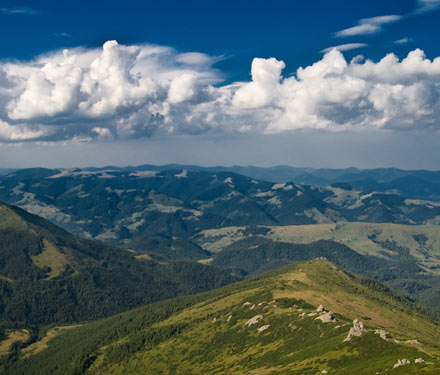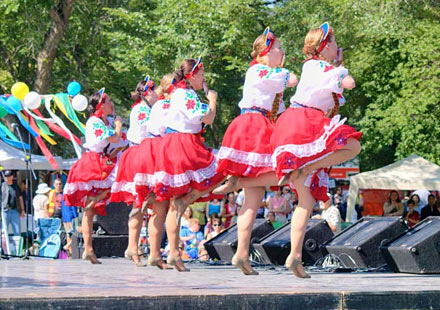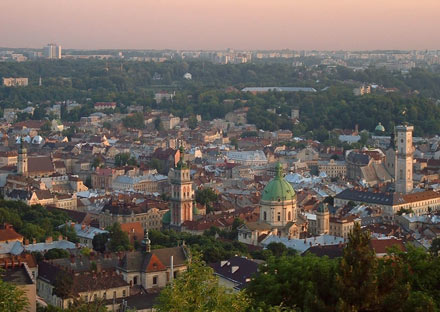Ukraine
Country statistics

Total area: 233,089 sq miles (603,700 sq km)
Population (2010 est.): 45,415,596 (growth rate: -0.6%); birth rate: 9.6/1000; infant mortality rate: 8.7/1000; life expectancy: 68.4; density per sq miles: 199
Capital City: Kyiv (Kiev)
Monetary unit: Hryvna
Languages: Ukrainian 67%, Russian 24%, Romanian, Polish, Hungarian
Ethnicity/race: Ukrainian 77.8%, Russian 17.3%, Belorussian 0.6%, Moldovan 0.5%, Crimean Tatar 0.5%, Bulgarian 0.4%, Hungarian 0.3%, Romanian 0.3%, Polish 0.3%, Jewish 0.2%, other 1.8% (2001)
Religions: Ukrainian Orthodox (Kiev Patriarchate 19%, Moscow Patriarchate 9%, no particular division 16%), Ukrainian Greek Catholic 6%, Ukrainian Autocephalous Orthodox 2%, Protestant, Jewish, none 38% (2004)
Country introduction

Ukraine is located in East Central Europe, bordering the Black Sea in the south, Poland, Slovakia and Hungary in the west, Belarus in the north, Moldova and Romania in the south-west and Russia in the east.
Ukraine has 2,782 km (1,728 miles) of varied coastline, from stunning white beaches to rocky shores. It has no inland bodies of water but enjoys a large number of fertile plains or steppes. The vast majority of the country consists of grassy, fertile plains and plateaus. The only mountains in Ukraine can be found in the west and extreme south of the country. The Carpathian Mountains are in the west and the Crimean Peninsula is in the south.
There are almost 23,000 rivers within the borders of Ukraine. Its longest river is the Dnieper (Dnipro) which is some 966 km (600 miles) long. Other notable rivers include the Dniester, Donets, Danube and Southern Buh. Lake Svityaz is one of the largest natural lakes in the country. Water is used for drinking, transportation and hydroelectricity and is considered to be a very important natural resource in the country.
The culture

There a lot of diversity and unique characteristics in Ukrainian culture with more than 110 ethnic groups. During the Renaissance and the rule of the Byzantine Empire, Ukrainian culture went through tremendous changes. Dominated by the Eastern Orthodox Church and pre-Christian traditions, Ukrainian culture also shares its origin with the neighboring Belarusian and Russian cultures. The origin of these three cultures can be traced to Kievan Rus.
The effects of the socialist style of living are evident in the region as a result of the enforcement of communist rule in Russia in the late 1920s. Ukrainian culture can be identified by the 'pysanky' (the painted Easter egg), the 'hopak' (the Ukrainian dance), the 'bandura' (the musical instrument), Cossacks, 'borscht' (the soup), the cooked chicken dish, and the 'salo'.
Orthodox Christianity is possibly the most popular religion in Ukraine, along with Eastern Catholicism. A number of holidays and festivals are celebrated by Ukrainians including popular Christian festivals such as Christmas, Easter, and New Year. There are also local festivals such as Whitsuntide and Ivana Kupala. There's a social gathering called Vechornytsi, which is commonly found on traditional holidays such as Koledaruvane and Ivan Kupala Day. The Ukrainian people celebrate togetherness and it is called "Razom nas bahato, nas ne podolaty".
Ukrainian dishes are often very rich and include cheese, fish, and many different types of sausages. Bread is included in almost all types of meals and during Easter, colored eggs are placed on the table around the bread. A special Ukrainian cuisine prepared on Easter and Christmas is "Kutia", which is a dish made from poppy seeds, wheat groats, honey, and sweet bread.
The effect of ancient traditions is visible in the songs and dances performed in the country. The Kozak is a popular dance from Central Ukraine with a long history. Initially, only men or women groups performed during cultural celebrations but now, mixed groups participate in various functions and enjoy the celebrations together. Other famous cultural dances of Ukraine are Kozachok, Hopak, and Tropak. The music and dance culture of Ukraine has a strong influence on Gypsy music and also the Jewish culture of Hava Nagila, which is also called "Let's Rejoice". Kalyna is a famous dancing style of Ukraine where women wear colorful clothes with matching aprons and tunics, and men wear baggy trousers with embroidered shirts.
Traditional Ukrainian music can be solo singing or ritual singing. Ritual singing is performed to signify an occasion such as birth, death or marriage. The folk music includes traditional instruments such as the bandura, the kobza (lute), violin, basolya, volynka (bagpipes), floyara, sopilka (duct flute), and buben (frame drum). A traditional ensemble is comprised of three musicians (troïstï muzyki) playing three instruments. The oldest forms of Ukrainian songs are Cossack songs and the cultural celebrations are also famous for certain cultural games such as Tavriya Games which are played during the celebrations. Two forms of contemporary Ukrainian music are the Kolomiya Rap and Polissia Magic Pop.
Attractions & landmarks

Ukraine is a very vivid country, rich in culture and history. There is much to offer tourists, many lovely sights, traditional sounds, decadent flavor and unique smells. One such Ukrainian attraction is St. Sophia Cathedral and Monastery, built during the 11th century. Also located in Kiev, the capital of Ukraine, are attractions such as The Golden Gate, Cathedral of St. Vladimir, Museum of Ukrainian Art, Andreyev Hill, the Opera House and the Historical Museum of Ukraine.
The city of Lviv is steeped with history and include narrow medieval streets paved with stones and architectural decorations all of which are still preserved in its original form. In ancient times Lviv was the capital of a mighty Slavic state called the Galicia-Volyn principality. Being a part of the Austro-Hungarian Empire and then Poland contributed to the formation of the city's unique image. a very poetic city. In addition to the amazing architecture, visitors can explore great Ukrainian attractions here including the National Museum, Antique Armory, Pharmaceutical Museum, Museum of Ethnography and Crafts, Museum of History and the Opera House of Ivan Franko.
The city of Odessa is a relatively young city, which was founded in 1794 by the Empress Catherine the Great. Odessa's 19th century houses built of limestone make it a light and inviting city. Many areas of Odessa look like an open sky museum. The city of Odessa is well-known for the Potemkin Stairway with its 192 steps. The city also boasts a beautifully decorated opera house, a statue of the Duke of Richelieu, the Archaeological Museum and the Vorontsov Palace.